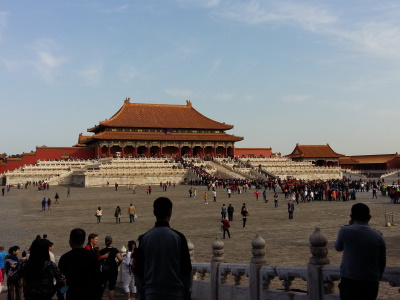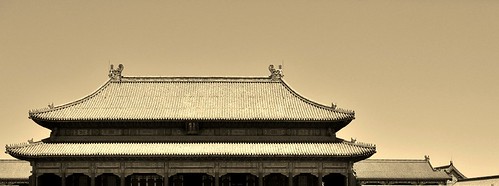Imperial Palace

The Imperial Palaces of the Ming and Qing Dynasties in Beijing and Shenyang with their grand palatial architecture represent State power in late feudal China
The Imperial Palace of the Ming Dynasty, commonly known as the Forbidden City, lies in Beijing and has been the residence of the Ming emperors since 1421. It represents the ritual and court culture of that period. The Imperial Palace of the Qing Dynasty was the secondary capital; the palace dates from the 17th century and its plan and architecture show the Manchu culture of this dynasty, including sacrificial places to practice Shamanism.
Community Perspective: The Forbidden City in Beijing stands out for its enormous scale, and takes hours to explore if you stray off the main path. The palace in Shenyang shows the intricate design of Manchu architecture.


Map of Imperial Palace
Community Reviews
Tony H.

I visited the Forbidden City in June 2024. You need to buy the tickets for the palace beforehand online. I did it through the official site and had no problems with it. Tickets become available 7 days in advance and if you plan to visit on weekend, on public holiday or during the morning slot you need to be on the website right when new batch of tickets become available. I found the afternoon tickets to be available even for next day on some weekdays but I scored for myself morning ticket during a weekday.
This site will be busy no matter when you visit and it becomes apparent already at the Tiananmen East metro station as you might need to queue even to exit the station. After exiting the Tiananmen East metro station the info signs will guide you towards eastern entrance to Forbidden City but I followed the masses to the Tiananmen Square. From there you walk through the Gate of Heavenly Peace with Mao looking at you peacefully from his iconic giant portrait. After multiple ticket and security checks you finally arrive to the Meridian Gate where the actual Forbidden City palace complex starts.
After walking through the Meridian Gate you are already stunned by the view of the Gate of Supreme Harmony and the Golden Stream that flows through the courtyard. Through west side of the courtyard you can visit Hall of Martial Valour that housed ceramics exhibition at the time of my visit, very much worth of visit. Not many people venture out there and it was the most peaceful part of Forbidden City that I visited. After passing the Gate of Supreme Harmony you are met with the best sight of the palace complex, the giant courtyard with Hall of Supreme Harmony. You won't experience much of that harmony with all the tour groups and their loud speakers but it's still a magnificent sight. The buildings in Forbidden City are decorated beautifully which you don't really notice until you're right next to them. There are also beautiful bronze statues of animals on show. You can't enter the Hall of Supreme Harmony or any other halls but there aren't much items on show inside of them anyway.
Next I visited the eastern palaces which include the Clock Museum (worth the visit) and the Treasure Gallery (too crowded but beautiful decorative items). Here you can also find the beautiful Nine Dragon Screen that protects the palace from evil spirits and the magnificent opera house. The eastern palaces require an extra ticket that on the website is titled as the ticket for the Treasure Gallery but it includes the whole eastern palaces section, which is very much worth the visit as you get close with the palace buildings and can admire the details much better. After the eastern palaces I walked around the Imperial Garden and checked out Palace of Heavenly Purity, Hall of Union and Palace of Earthly Tranquility. I had quick look at the western palaces section but as at that point I had already stayed in the palace for almost 4 hours and temperature had risen to 36 degrees Celsius, I decided to end my visit and exit through the North Gate.
At the Meridian Gate I had rented an audio guide for the visit. They advertise that they got them in dozens of languages so I decided to check out how their Finnish audio guide was. Well, firstly it took some time until the workers at the audio guide booth understood that there's a language called Finnish and they truly have audio guide in that language, so I assume the smaller languages aren't requested very often. And secondly, the audio guide was bad. It only worked at the biggest attractions but most of the palace complex didn't have narration in Finnish, and the narrator was barely understandable with her extremely heavy Chinese accent. But the map on the audio guide was very helpful for walking around the palace complex. I also found the information signs of different attractions being quite good so the audio guide for me was a flop. Otherwise the visit was surprisingly pleasant despite the crowds and heat and I enjoyed truly my time in Forbidden City. When I return to Beijing I will visit Forbidden City again and check out the sections I missed on the first time.
Clyde

I visited this WHS in October 2013. First I visited Tiananmen Tower, then I proceeded to the Forbidden City proper. The different halls are beautiful and the whole place is amazingly huge. Crowds of tourists and locals visit, yet if you walk just a few steps from the centre path of this site you can still enjoy it at your own pace. The seven bridges are intricately carved and the palace reflecting in the water was the highlight of my visit. I also liked the colorful pavilions in the park just opposite the exit of the imperial palace.
Kyle Magnuson
California - United States of America - 28-Dec-11 -

I visited the Imperial Palace in Beijing twice. Once in 2006 and once in 2007. A true exploration of the site runs about half a day. It is worthwile to explore the side sections of the palace. Each side passage or courtyard reveals something new and is quite interesting to search in depth. Moreover, large restored sections of the palace are being opened every couple years. Suprisingly, vast sections of the palace are still closed and are scheduled to be revealed to the public in the not too distant future. Try not to visit the palace in the summer or weekend if possible as it gets clogged with people (literally).
The tile panels are certainly a highlight, and side alleys have a more personal atmosphere that you don't find walking near or around the central axis. I prefer weekday mornings, if you are lucky with the smog, the pictures can be incredible.
Read more from Kyle Magnuson here.
Ian Cade

I must admit I wasn't especially looking forward to this visit; it had more of a feeling of something I should do rather than wanted to do. However after a few hours of strolling around the Forbidden City I was happy that I had seen it and ducking off to the sides could make it a surprisingly quiet experience even on a weekend afternoon.
The sheer size of the first part of the palace is what really grabs you, as Ben has stated below it takes a massive site to be able to swallow these large crowds and it certainly did that, it would be odd to see such large spaces with only a small amount of people in them. The main temples and pavilions really were impressive and I spent a fair bit of time just taking in their wonderful architecture and paintings.
After the grand ceremonial buildings at the front the rear of the palace is a series of interlocking courtyards and private palace quarters which were reasonably interesting, however the crowds felt a little denser here and I started to wane a little so decided to head on out before palace fatigue really set in.
I enjoyed my visit here more than I thought I would and the grand ceremonial parts of the complex allow you to get a sense of the awesome scale of the place as well as a chance to escape the crowds.
[Site 7: Experience 7]
Boj
Philippines & China - 16-Nov-10 -

The Shenyang Imperial Palace may not be as grand as its Beijing counterpart; however, what makes up for its size is the intricate design of the buildings. The Manchu style of architecture is not like any other seen in most temples or buildings in China.
I stayed in Shenyang for two days and got to visit the other two Qing dynasty tombs in the city - Zhaoling and Fuling.
Rajeev Aloysius
I took an entire day to visit the Imperial Palace in Beijing, popularly known as The Forbidden City. It is a central enclave facing Tiananmen Square. I first walked the South - North axis, and then returned to see the Seven Dragons Wall, Archery Pavilion, East Palaces and West Palaces in the Imperial Gardens. The scale and the artistry, as well as the strange names of the pavilions, halls, gardens and monuments were fascinating.
Kang Chong
I went this Palace in a tour group. Due to time constraints, we were made to walk from the "Wu Men" (front) all the way to the back. One straight path passing all the main palaces. Do not forget to visit some of the palaces at sides. These are hidden treasures with less tourists and more intrigue. Certain smaller palaces even house artefacts etc. Also, do not forget to climb the hill "Jing Shan" (create from the earth excavated from the construction of the palace) at the back of the palace compounds. This will offer you a breathtaking view of the whole palace compound. Definitely worthwhile spending more time exploring the entire compound!!!
Ben Pastore
Only the Forbidden City could host so many throngs of tourists and still seem huge. The open areas are truly impressive and the famous landmarks are even better in real life. It is another one of those "If I'm here, I have to see it" places and a worthy entrant on the World Heritage List
C H Ho
Hong Kong, China - 01-May-05 -
The Forbidden City may be the largest palace in East Asia. However, many treasury are stored in the Imperial Palace Museum in Taiwan. The former government moved the treasury to Taiwan before turnover to Communists in 1949. Therefore, tourists visit the architechture of the palace mainly.
Rob Wilson
The Forbidden City is possibly the most packed tourist attraction I've ever visited. Thankfully, it is still well worth the visit.
The sheer scale and opulence of the place it quite astonishing.
Els Slots

The Forbidden City is a huge complex at the center of Beijing (behind the Tiananmen gate), that nowadays attracts thousands of visitors every day. I entered from the North, so I was met with innumerable (mainly Chinese) groups that had started from the main entrance in the South.
The funny thing is that everybody clings to the main path (the North-South axis) and that 10 meters to the right or left you're almost on your own.
The complex is surely meant to impress: everything is just huge. You have to take your time to find and look at the details. What I liked most were its simple but effective colours: bright red walls, with green and yellow accents in the tiles.
Community Rating
- : Solivagant Jon Bauer Khuft Walter Ivan Rucek Zhenjun Liu Craig Harder Jeffrey Chai Ran Alexander Barabanov Alexander Parsons Chenboada DAB Ralf Regele Sachin YAO WEI Luke LOU Michael anak Kenyalang Maciej Gil Violeta Yinming Zhang BH HaraldOest Yiqun Jin NonDuality AT8 Panacci Rogerding Travelure Dejulis@hotmail.com Priyaranjan Mohapatra Mihai Dascalu Ovalarezo Nathan Allnamesused Amitlchoudhuryjbp StaziG Bluewonder310 Mo-han Je Marinemajor Laurine Alejandro Lau Ssong.x Awestix Collisions Javier KngAlaric
- : Frederik Dawson Tony H. Kyle Magnuson Philipp Peterer Jan Zimmermann Thibault Magnien Stanislaw Warwas Antonio J. Dwight Zehuan Xiao Christravelblog Hanming Philipp Leu JoStof Kbtwhs Juropa Pchxiao Inomusay Tingmelvin Tikhon Puliaev Fmaiolo@yahoo.com Ljowers Oscar Wu Trekkie900 CeeCeeSR ReallyDeepThoughts
- : Els Slots Peter Lööv Peter Alleblas Clyde Nan Randi Thomsen Svein Elias Xiquinho Silva Shandos Cleaver Dennis Nicklaus Kevin McFarland Lucio Gorla Kasper Carlo Sarion Palimpsesto Richard Stone Dorejd 50pagesofshawn KoenigMarke Richardleesa Alikander99 Mauralin13 Xtopher33 Cutecid Gordon Mitchell GerhardM Shwabb1 J_neveryes Federico P. KeithBailey Everett Velvetlapis
- : Mikko DL Chalamphol Therakul Stanimir Zoë Sheng CalvinLoh Merveil Timonator JobStopar Rodinia JR's HERITAGE SITES Alygeddon Csaba Nováczky
- : Ian Cade Col Alexander Lehmann George Gdanski Alex Marcean VLabhard AGuzzo Tourb
- : Julio Moreno Adrian Turtschi Kelseyyurek
Site Info
Site History
2004 Extended
To include the Imperial Palace of the Qing Dynasty in Shenyang
2004 Name change
From "Imperial Palace of the Ming and Qing Dynasties, China" to "Imperial Palaces of the Ming and Qing Dynasties in Beijing and Shenyang"
1987 Inscribed
Site Links
Unesco Website
Official Website
In the News
From the Forum
Connections
The site has 58 connections
Art and Architecture
Constructions
Geography
History
Human Activity
Individual People
Literature and Film
Religion and Belief
Science and Technology
Timeline
Trivia
WHS Hotspots
WHS on Other Lists
World Heritage Process
Visitors
654 Community Members have visited.
The Plaque
